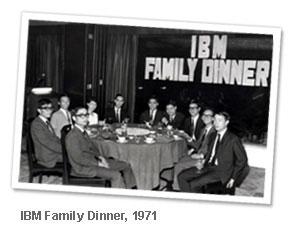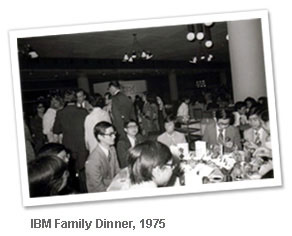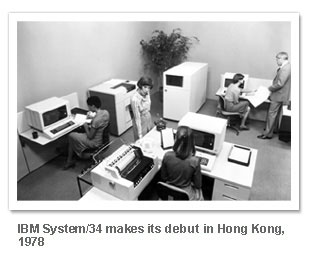

Many other firms and organisations latched on to the capabilities
of the S/370 series. With demand for computer processing growing, in
1979 The Hong Kong and Shanghai Banking Corporation installed a 3032
system. A compatible member of the S/370 family, the 3032 processor
was designed for users who wanted to expand their data processing
capability but did not require the capacity or performance of IBM’s
top-of-the-line 3033 Processor. The internal instruction execution
rate of the 3032 Processor was 2.5 to 3 times faster than the S/370
Model 158-3 used for running similar programs and configurations. In
the same year, Hongkong Electric purchased and installed a 3031
system, replacing existing systems supplied by others.
In 1978, the introduction of the mid-range System/34 (S/34)
computing system and its peripheral applications once again
drastically lowered the cost of installing a state-of-the-art
computing system. Instead of paying in the region of US$1 million
for a mainframe system, companies with HK$1 million to spend had
access to the latest computing system. 
Unlike the S/360 series, the large chest-freezer-size mid-range
computing systems did not require a false floor to hold the
machine's weight, or three-phase electrical power. Considered one of
the most significant milestones of the 1970s, the potential of
affordable and compact computing systems was soon embraced by
manufacturers, import/export firms and other midsized companies. In
addition, companies and organisations that had previously used IBM’s
data processing services through the Service Bureau also began to
invest in their own computing systems.
Perhaps most importantly, the mid-range systems allowed customers
to use a lower-cost model and then upgrade to larger systems as
their needs grew. This flexibility greatly lowered barriers to
entry. With most other vendors, customers had to choose between
machines they could outgrow and machines that were potentially
overpowered, making them too expensive. This meant that many
companies simply didn’t buy computers. The S/34 and the later
System/36 (S/36) and System/38 (S/38) computing systems changed the
entire nature of the market as companies could now install machines
at a lower initial cost. 
ARRIVAL OF THE S/34
The S/34 was a particularly interesting machine. Considered by
IBMers as a mid-range system (although it was the size of a large
washing machine and weighed nearly 300 kg), the S/34 could support
multiprogramming, multiple processors, up to 36 peripheral devices,
job queues, printer queues, security and indexed file support.
Costing significantly less than its predecessors, the computer
proved to be the ideal tool for companies spreading their wings in
the alluring mainland manufacturing market, enabling them to take
advantage of low-cost mainland labour and manufacturing space while
monitoring and controlling costs and inventory with fast and
effective computer programs. |

